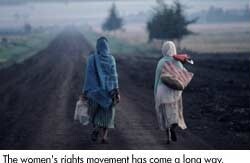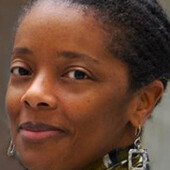The past decade has seen women’s rights activists from every region of the world mobilize to use the international human rights system to raise awareness about and remedy the staggering levels of violence against women. Activists’ most significant achievements include proving a state’s failure to prevent or respond to domestic violence to be a human rights abuse; creating better fact-finding mechanisms to document violence against women; increasing the role of UN agencies in adopting and promoting strategies to combat gender-based violence; using public tribunals to create a public record of violence against women; improving state response to violence against women perpetrated by private actors; getting a range of gender-based and sexual violence in armed conflict codified as a war crime and a crime against humanity; identifying harmful traditional practices, such as female genital mutilation (FGM), as violence against girls and women; defining and criminalizing at the national level the myriad forms of violence against women; raising overall public awareness that gender-based violence is a chronic human rights abuse; and supporting the efforts of more “mainstream” human rights organizations to integrate women’s human rights into their work.
One such organization is the New York–based Human Rights Watch (HRW). In 1990, HRW’s first executive director, Aryeh Neier, championed the creation of a special project on women’s rights and raised start-up funds for it from a group of private donors and foundations. HRW was the first mainstream human rights organization to start a special project devoted exclusively to defining and documenting women’s human rights abuses. By creating the Women’s Rights Project, HRW recognized the need to develop and improve its capacity and expertise on women’s human rights—and by so doing positioned itself to be a major leader in the field of advancing women’s human rights globally.
The very first issue the newly formed Women’s Rights Project tackled was violence against women in Brazil. Their report, Criminal Injustice: Violence Against Women in Brazil, contains the findings of their investigation into wife-murder, domestic battery, and rape—a new and highly contested area for many traditional human rights organizations. Among other issues, the report focused generally on impunity for violence against women, and in particular on the issue of the honor defense to exculpate husbands accused of killing their wives. The report was the first by a mainstream human rights organization to argue for state responsibility to combat violence against women in the home. Over the next thirteen years, the Women’s Rights Project (since 1997 the Women’s Rights Division) evolved into a full-fledged, integral part of HRW, undertaking pathbreaking conceptualization, fact-finding, and advocacy on a wide variety of violence and discrimination against women.
The women’s rights movement put violence against women on the international human rights agenda by pushing, fighting, cajoling, stigmatizing, strategizing, coalition building, and simply being steadfast and refusing to go away. Women’s rights activists embraced human rights instruments that had historically been used by and large to defend men’s human rights and transformed them into tools to promote women’s human rights.
Part of integrating violence against women into the mainstream human rights movement required the creative use of the classic human rights framework to define the violence that women were experiencing and to chart a course for government accountability. Women’s rights activists interpreted existing human rights norms and laws in ways to afford women greater protection from violence. They used existing international human rights norms—on, among other things, discrimination, torture, due diligence, equality before the law, bodily integrity, and the right to health and life—to call attention to and craft remedies to eradicate the pandemic of violence against women throughout the world. For example, women’s rights activists used the Convention against Torture to define rape in armed conflict and custodial sexual violence. They used equality before the law provisions to push for more vigorous investigation and prosecution of domestic violence. They used provisions on government obligation to eliminate harmful customary practices to address FGM.
One of the most important strategies the women’s human rights movement adopted was to question the legitimacy of the mainstream human rights movement if women’s human rights were not fully integrated into it. Women’s rights activists challenged the legitimacy and effectiveness of a conceptualization of human rights that emphasized violence by the state but overlooked violence by private actors.
Women’s rights activists mobilized at important world fora, such as the 1993 Vienna World Conference on Human Rights (Vienna); the 1994 International Conference on Population and Development (ICPD) in Cairo; and the 1995 UN Fourth World Conference on Women (FWCW) in Beijing, China, to advance women’s rights, to push for better and more durable protections against gender-based violence. To that end, Vienna was a watershed event. In a Global Campaign for Women’s Human Rights that was coordinated by the Center for Women’s Global Leadership, over 200,000 people in 120 countries signed a petition aimed at the United Nations to get women’s rights on the agenda. In the initial agenda for Vienna, women appeared only when listed as a vulnerable group. Women’s rights activists and NGOs transformed the conference into a staging ground for the emergence of a powerful message about the indivisibility of human rights. This message positioned women’s human rights squarely at the core of the movement. Any human rights movement that did not have the struggle for women’s rights at its core was considered bankrupt and ineffective. The ICPD program of action demonstrated the ways that violence against women prevented women from exercising reproductive rights and health. The FWCW’s platform for action identified violence against women as a pervasive threat to women’s lives—at every stage of their lives, from cradle to grave. Together, these fora established recognition of gender-based violence as a chronic and debilitating plague on women’s lives and committed the UN to use its broad influence to urge governments to implement sophisticated, long-term strategies to end gender-based violence.
Though attempts to eradicate violence against women have been made more effective with the use of a human rights framework, it is also the case that activism on women’s human rights issues generally—and on gender-based violence in particular—has strengthened the human rights movement more broadly. First, the movement has greater legitimacy and effectiveness now that it addresses a more representative range of human rights abuses that occur throughout the world. Second, the mobilization and coordination that women’s rights activism has brought to the international human rights movement (on the International Criminal Court, the Optional Protocol to CEDAW, the Protocol to the African Charter on Human and People’s Rights, the creation of Special Rapporteurs, and so on) has meant improved rights education and capacity building for new and important constituencies. Third, increasing expectations for respect for women’s human rights at all levels of government creates overall improved respect for many other citizens who were historically abused by the state and individuals. Last, increased government accountability for nonstate actor abuses has provided a tremendous opportunity to the human rights movement to further adapt its strategies and use the human rights framework to identify and remedy abuses perpetuated by corporate entities.
As a global human rights movement, we have made meaningful advances against gender-based violence, but, disappointingly, there are still significant hurdles ahead that risk diluting and undermining any progress. The first and perhaps greatest challenge involves the failure of the human rights movement to respond more vigorously to sex-based discrimination as a chronic and debilitating human rights violation. Gender nondiscrimination is not a jus cogens norm under international human rights law. This shortcoming virtually ensures that women will forever remain the victims of gender-based violence. To begin to remedy this failure would mean addressing more thoroughly the underlying human rights abuses that so predictably render women at risk for violence: women’s legal, cultural, and social subordination to men; regulation of women’s sexual activity; unequal access to educational opportunities; unequal and obstructed access to reproductive health care information and services; and discriminatory access to work.
Other challenges include making redress and accountability more accessible to women victims of violence; ensuring that more mainstream human rights organizations devote considerable resources and energies to work on a range of women’s human rights issues; developing rigorous standards and recommendations for prevention of violence against women in the first instance; providing clearer guidance to governments on minimum standards to prevent violence against women and to ensure protection against violence once it occurs; improving lasting accountability; and examining ways to afford women greater protection from gender-based violence through the protection of the rights articulated in the International Covenant on Economic, Social and Cultural Rights.
The human rights framework has been a particularly effective tool to combat violence against women by defining the violence perpetuated against women as a human rights abuse. No one should underestimate the enormity of this accomplishment. Extracting violence against women from the cultural or private sphere and showing government responsibility on this issue was essential. Yet, absent a deepening of the human rights framework’s response to violence against women, we may be stalled at having made significant advances in critical areas over the past decade but not creating the conditions whereby women are less at risk for gender-based violence in the first instance.




